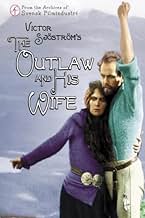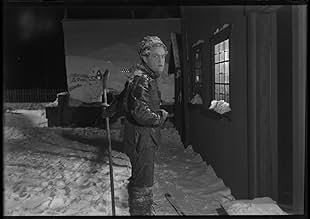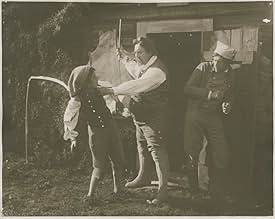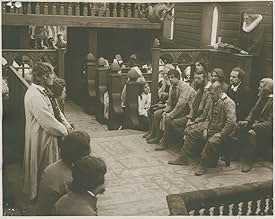IMDb रेटिंग
7.1/10
2.2 हज़ार
आपकी रेटिंग
अपनी भाषा में प्लॉट जोड़ेंEjvind and his family are in need of food. So Ejvind seeks help from the rich priest next door. He refuses to help. Ejvind then steals a sheep from the priest, he is caught. But he escapes f... सभी पढ़ेंEjvind and his family are in need of food. So Ejvind seeks help from the rich priest next door. He refuses to help. Ejvind then steals a sheep from the priest, he is caught. But he escapes from prison, and becomes an outlaw.Ejvind and his family are in need of food. So Ejvind seeks help from the rich priest next door. He refuses to help. Ejvind then steals a sheep from the priest, he is caught. But he escapes from prison, and becomes an outlaw.
- निर्देशक
- लेखक
- स्टार
Walerie Alexandrow-Höök
- Berg-Ejvinds och Hallas dotter Tota
- (as Walerie Alexandrow)
फ़ीचर्ड समीक्षाएं
It is a truism that Victor Sjostrom's films dramatise the conflict between nature and society, but his treatment is less simplistic than might be first apparent. For instance, society in 'The Outlaw and his Wife' is ruled by a brutal, land-grabbing Bailiff who whips servants for losing a sheep; but it is also a place rich in pageantry, costume and rite, where communities can express themselves.
Similarly, nature might be a site of freedom for social outsiders, a sustaining idyll for lovers, and an awe-inspiring backdrop, but it also overflows in the lonely vagrant who comes close to rape, or the cliff and snows that can kill.
Throughout Sjostrom shifts impressively between registers - nature as both real presence and symbolic backdrop; plot as both social depiction and spiritual journey - while retaining familiar action pleasures.
Similarly, nature might be a site of freedom for social outsiders, a sustaining idyll for lovers, and an awe-inspiring backdrop, but it also overflows in the lonely vagrant who comes close to rape, or the cliff and snows that can kill.
Throughout Sjostrom shifts impressively between registers - nature as both real presence and symbolic backdrop; plot as both social depiction and spiritual journey - while retaining familiar action pleasures.
It's hard to imagine, but only a few years before this film debuted, most films were only a few minutes long. And, full-length films really were a pretty new thing. So, to see a long, complex and cinematic film like "You and I" shows just how far the industry had grown. Victor Sjöström plays a man who is on the run from the law. Years earlier, he'd been sent to prison for stealing a sheep to feed his family and he'd eventually broken out of a tiny make-shift prison in Iceland. The film picks up when he's on the run in the interior of the country--looking for work and hoping no one recognizes him. In the process, a woman takes him in to work on her farm and eventually the two fall in love....at about the time the law shows up to claim him. The two run off together and live in the inhospitable wilds for the next 17 years (yikes). Exactly what happens is something you'll just need to see for yourself--but it does have some nice surprises.
The film is well worth seeing mostly for the nice acting and cinematography. Interestingly, in addition to starring in the film, Sjöström directed and co-wrote this film--and the look of the film can clearly be attributed to him. I also appreciate how he was able to recreate the look of Iceland nicely by apparently filming in the middle of no where AND in pretty inhospitable weather. A very good film--and it has some nice things to say about crime and punishment.
The film is well worth seeing mostly for the nice acting and cinematography. Interestingly, in addition to starring in the film, Sjöström directed and co-wrote this film--and the look of the film can clearly be attributed to him. I also appreciate how he was able to recreate the look of Iceland nicely by apparently filming in the middle of no where AND in pretty inhospitable weather. A very good film--and it has some nice things to say about crime and punishment.
The Outlaw and His Wife (1918) directed by Victor Sjöström is yet another impressive production in early cinema history.
The story revolves around a stranger who comes to work at a widow's (Halla's) farm. Halla and the stranger fall in love, but when he is revealed as Eyvind, an escaped thief forced into crime by his family's starvation, they flee and become two of the many outlaws of Iceland's mountains.
Victor Sjöström's early films are impressive in their own right. In The Outlaw and his Wife, he almost uses nature as a character, pressuring the humans of the film to the very brink of - and beyond - their moral values. This works effectively in driving a more abstract point of the film; what is one willing to do in order to ensure one's own safety and survival, and yet further abstract; what is good and evil as philosophical constructs?
It is similarly highly recommended for film buffs and those interested in cinema history just like Sjöström's earlier film Terje Vigen (1917), although The Outlaw and his Wife is not as contemporary as Terje Vigen. Lacking a score and being twice as long, it does not feel as focused although it definitely is more epic in its scale and production.
The story revolves around a stranger who comes to work at a widow's (Halla's) farm. Halla and the stranger fall in love, but when he is revealed as Eyvind, an escaped thief forced into crime by his family's starvation, they flee and become two of the many outlaws of Iceland's mountains.
Victor Sjöström's early films are impressive in their own right. In The Outlaw and his Wife, he almost uses nature as a character, pressuring the humans of the film to the very brink of - and beyond - their moral values. This works effectively in driving a more abstract point of the film; what is one willing to do in order to ensure one's own safety and survival, and yet further abstract; what is good and evil as philosophical constructs?
It is similarly highly recommended for film buffs and those interested in cinema history just like Sjöström's earlier film Terje Vigen (1917), although The Outlaw and his Wife is not as contemporary as Terje Vigen. Lacking a score and being twice as long, it does not feel as focused although it definitely is more epic in its scale and production.
I have waited for years to see this film and finally caught it on Youtube - in excellent condition. It was definitely worth the wait! The film was made in 1918, a time when most cinema consisted of small segments of celluloid patched together with the standard melodramatic or comedic situations, clumsily filmed indoors on make-shift sets. This is absolutely nothing of the kind although it took Hollywood what seemed an eternity to figure out that a movie could, indeed, be shot out in the open with great success. Several reviewers have mentioned some sort of connection with early Westerns made by directors of little artistic talent and less scope. Actually, this film has nothing whatsoever to deal with standard plots with famous actors. The plot is extremely simple, as it should be in this case, and all - virtually all - of the over-the-board overacting and the theatrical motions and over-emotions suppressed, with natural gestures replacing them in natural settings...and what beautiful settings they are! No, there aren't any tied-together happy ends around and little to titillate the audience, villains with mustaches or any of the standard American clichés here. The film is Scandinavian, filmed and acted by Scandinavians, shot in North Sweden far, far away from the ole corral. I don't know how well the director, Victor Sjostrom, was acquainted with American cinema at the time - there wasn't really much of anything of much value going except from Griffith and one or two others, but the film borrows nothing and invents everything for its own uses. The cinema up there created a universe of its own, albeit a harsh one. Bergman would follow fifty years later. This was a welcome hour or so spent in the company of people who made some astoundingly good films and this is certainly one of them.
Curtis Stotlar
Curtis Stotlar
Berg-Ejvind Och Hans Hustru / The Outlaw and His Wife (1918) :
Brief Review -
A tragic love story of an Icelandic outlaw with a groundbreaking filming process. The first thing you should know about The Outlaw and His Wife is that it's a groundbreaking film when it comes to cinematography and the shooting process. It was groundbreaking for its portrayal of wild nature, as it was shot in two sessions in the spring and late summer. We modern audiences and critics talk about Richard Linklater's "Boyhood" (2014) for its long filming process that took 12 years or something, but how many of us ever discuss old treasures like this? We should, and I am doing my part today. Victor Sjöström's silent romantic tragedy has everything that makes for a good watch. The storyline is exactly what any romantic melodrama will have. It has emotion and that love factor working as the USPs throughout the narrative. At one point, I thought it was trying to be philosophical, but then everything went as planned, and believe me, I was hoping it would behave like a film made 104 years ago. A stranger comes to work at widow Halla's farm. She falls in love and he shares her feelings, but their happiness is cut short by God or destiny, whatever you call it, as his haunting past strikes with new challenges. Halla learns about Eyvind's past and yet decides to follow him for life. What challenges she had to face in the marriage and how they both tackled them is all that you get to see in The Outlaw and His Wife. Victor Sjöström's film seems like an extremely expressionist film, as Victor Sjöström and Edith Erastoff both give such exorbitant expressions. Also, we can't forget the fact that the cinema of 1918 was like this, even if it was changing rapidly in the West. Nevertheless, the greatest Swedish director of its time makes sure that your time is worth spending on something. Love story and love tragedy lovers should definitely see this to know the true meaning of love.
RATING - 7/10*
By - #samthebestest.
A tragic love story of an Icelandic outlaw with a groundbreaking filming process. The first thing you should know about The Outlaw and His Wife is that it's a groundbreaking film when it comes to cinematography and the shooting process. It was groundbreaking for its portrayal of wild nature, as it was shot in two sessions in the spring and late summer. We modern audiences and critics talk about Richard Linklater's "Boyhood" (2014) for its long filming process that took 12 years or something, but how many of us ever discuss old treasures like this? We should, and I am doing my part today. Victor Sjöström's silent romantic tragedy has everything that makes for a good watch. The storyline is exactly what any romantic melodrama will have. It has emotion and that love factor working as the USPs throughout the narrative. At one point, I thought it was trying to be philosophical, but then everything went as planned, and believe me, I was hoping it would behave like a film made 104 years ago. A stranger comes to work at widow Halla's farm. She falls in love and he shares her feelings, but their happiness is cut short by God or destiny, whatever you call it, as his haunting past strikes with new challenges. Halla learns about Eyvind's past and yet decides to follow him for life. What challenges she had to face in the marriage and how they both tackled them is all that you get to see in The Outlaw and His Wife. Victor Sjöström's film seems like an extremely expressionist film, as Victor Sjöström and Edith Erastoff both give such exorbitant expressions. Also, we can't forget the fact that the cinema of 1918 was like this, even if it was changing rapidly in the West. Nevertheless, the greatest Swedish director of its time makes sure that your time is worth spending on something. Love story and love tragedy lovers should definitely see this to know the true meaning of love.
RATING - 7/10*
By - #samthebestest.
क्या आपको पता है
- ट्रिवियाBased on the story of Eyvindur of the Mountains (1714-1783), an outlaw in Iceland who fled into the mountains with his wife around 1760 and remained there for twenty years.
- इसके अलावा अन्य वर्जनTurner Classic Movies has shown on TV a restored version copyrighted in 1968 by Svenska Filminstitutet (The Swedish Film Instute). The restoration credits are in Swedish, but some of the original cast and crew credits are in English. All intertitles are in English and the film runs 73 minutes.
- कनेक्शनFeatured in Victor Sjöström - ett porträtt av Gösta Werner (1981)
- साउंडट्रैकKung Kristian II, op. 27
Composed by Jean Sibelius (1898)
टॉप पसंद
रेटिंग देने के लिए साइन-इन करें और वैयक्तिकृत सुझावों के लिए वॉचलिस्ट करें
- How long is The Outlaw and His Wife?Alexa द्वारा संचालित
विवरण
- रिलीज़ की तारीख़
- कंट्री ऑफ़ ओरिजिन
- आधिकारिक साइट
- भाषा
- इस रूप में भी जाना जाता है
- The Outlaw and His Wife
- फ़िल्माने की जगहें
- Nuolja, Abisko, स्वीडन(mountain scenery)
- उत्पादन कंपनी
- IMDbPro पर और कंपनी क्रेडिट देखें
बॉक्स ऑफ़िस
- बजट
- SEK 1,00,000(अनुमानित)
- चलने की अवधि1 घंटा 12 मिनट
- ध्वनि मिश्रण
- पक्ष अनुपात
- 1.33 : 1
इस पेज में योगदान दें
किसी बदलाव का सुझाव दें या अनुपलब्ध कॉन्टेंट जोड़ें

टॉप गैप
By what name was Berg-Ejvind och hans hustru (1918) officially released in Canada in English?
जवाब





























